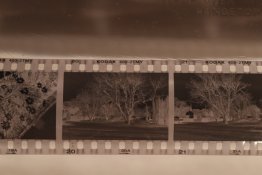xisbrat
Member
- Joined
- Nov 7, 2007
- Messages
- 19
- Format
- 35mm
I have a very strange symptom occurring intermittently when developing 35mm film, and wondering if this group can provide some ideas on what the problem might be.
I develop two rolls of film (Kodak TMY400) at a time, using steel reels in an inversion tank. One roll of film comes out fine, and the other roll has (what looks like light) streaks along both edges of the film, emanating from the four corners of the sprocket holes. In many of the frames, the streaks extend into the image, and on the image it looks like stalagmites and stalactites encroaching towards the middle of the frame.
This occurs along the entire length of the roll, from frame 1 to frame 24.
The image itself appears fine: good density, contrast, etc.
I used D76 1:1, kodafix solution, and agitate 5 inversions every 30 seconds.
I fill the tank to the top, so the problem is not insufficient solution. For the most recent occurrence, the roll at the bottom of the tank shows the symptoms; the roll at the top turned out fine.
I am suspecting a light leak in the camera, but cannot understand where the leak could be occurring from.
Any ideas? Thanks in advance for your comments.
I develop two rolls of film (Kodak TMY400) at a time, using steel reels in an inversion tank. One roll of film comes out fine, and the other roll has (what looks like light) streaks along both edges of the film, emanating from the four corners of the sprocket holes. In many of the frames, the streaks extend into the image, and on the image it looks like stalagmites and stalactites encroaching towards the middle of the frame.
This occurs along the entire length of the roll, from frame 1 to frame 24.
The image itself appears fine: good density, contrast, etc.
I used D76 1:1, kodafix solution, and agitate 5 inversions every 30 seconds.
I fill the tank to the top, so the problem is not insufficient solution. For the most recent occurrence, the roll at the bottom of the tank shows the symptoms; the roll at the top turned out fine.
I am suspecting a light leak in the camera, but cannot understand where the leak could be occurring from.
Any ideas? Thanks in advance for your comments.











